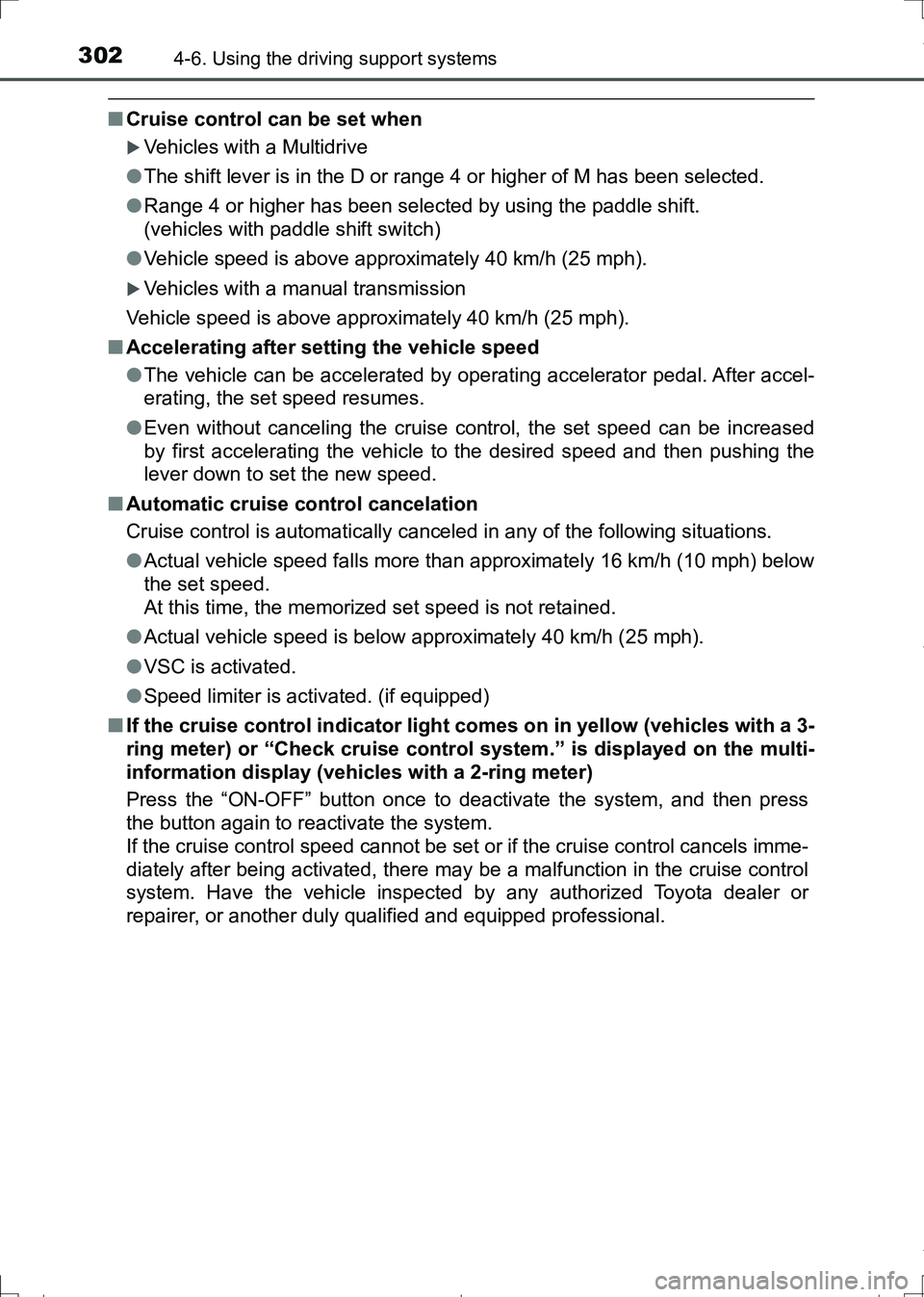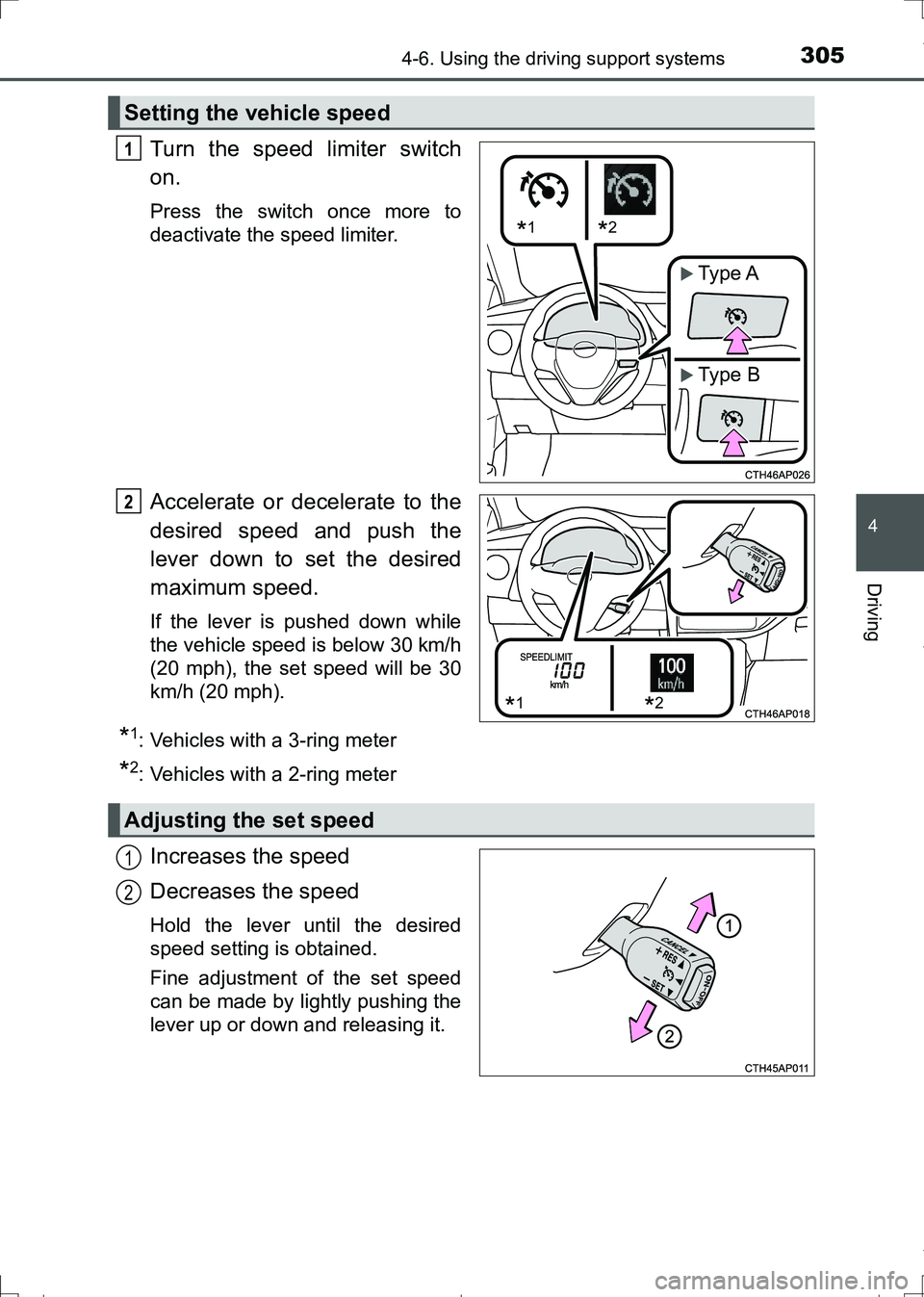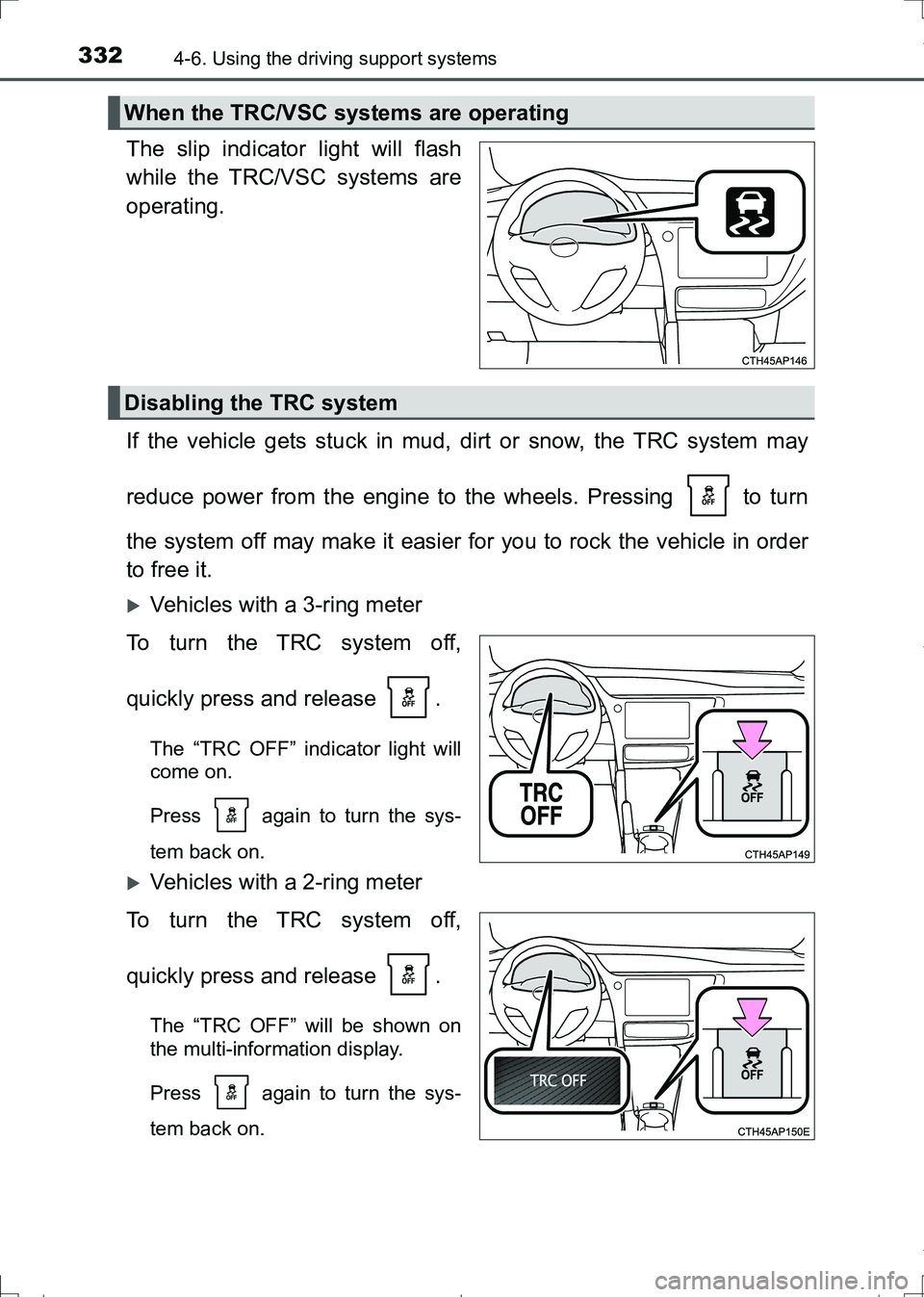2017 TOYOTA AURIS HYBRID light
[x] Cancel search: lightPage 279 of 664

2794-5. Toyota Safety Sense
AURIS Touring Sports_EE (12L13E)
4
Driving
●In the situations shown below, the system may not be able to accurately
detect surrounding brightness levels. This may cause the low beams to
remain on or the high beams to cause problems for pedestrians, vehicles
ahead or other parties. In these cases, manually switch between the high
and low beams.
• In bad weather (rain, snow, fog, sandstorms, etc.)
• The windshield is obscured by fog, mist, ice, dirt, etc.
• The windshield is cracked or damaged.
• The front sensor is deformed or dirty.
• The front sensor temperature is extremely high.
• Surrounding brightness levels are equal to those of headlights, tail lights
or fog lights.
• Vehicles ahead have headlights or tail lights that are either switched off,
dirty, are changing color, or are not aimed properly.
• When driving through an area of intermittently changing brightness and
darkness.
• When frequently and repeatedly driving ascending/descending roads, or
roads with rough, bumpy or uneven surfaces (such as stone-paved
roads, gravel tracks, etc.).
• When frequently and repeatedly taking curves or driving on a winding
road.
• There is a highly reflective object ahead of the vehicle, such as a sign or
a mirror.
• The back of a vehicle ahead is highly reflective, such as a container on a
truck.
• The vehicle’s headlights are damaged or dirty, or are not aimed properly.
• The vehicle is listing or titling due to a flat tire, a trailer being towed, etc.
• The high beam and low beam are repeatedly being switched between in
an abnormal manner.
• The driver believes that the high beam may be causing problems or dis-
tress to other drivers or pedestrians nearby.
AURIS Touring Sports_OM_Europe_OM12L13E.book 279 ページ 2016年6月27日 月曜日 午後5時21分
Page 284 of 664

2844-5. Toyota Safety Sense
AURIS Touring Sports_EE (12L13E)■Conditions in which the function may not operate or detect correctly
In the following situations, RSA does not operate normally and may not rec-
ognize signs, display the incorrect sign, etc. However, this does not indicate a
malfunction.
●The front sensor is misaligned due to a strong impact being applied to the
sensor, etc.
●Dirt, snow, stickers, etc., are on the windshield near the front sensor.
●In inclement weather such as heavy rain, fog, snow or sand storms
●Light from an oncoming vehicle, the sun, etc., enters the front sensor.
●The sign is small, dirty, faded, tilted or bent, and if an electronic sign, the
contrast is poor.
●All or part of the sign is hidden by the leaves of a tree, a pole, etc.
●The sign is only visible to the front sensor for a short amount of time.
●The driving scene (turning, lane change, etc.) is judged incorrectly.
●Even if it is a sign not appropriate for the currently traveled lane, such a sign
exists directly after a freeway branches, or in an adjacent lane just before
merging.
●Stickers are attached to the rear of the preceding vehicle.
●A sign resembling a system compatible sign is recognized.
●The vehicle is driven in a country with a different direction of traffic.
●Side road speed signs may be detected and displayed (if positioned in sight
of the front sensor) while the vehicle is traveling on the main road.
●Roundabout exit road speed signs may be detected and displayed (if posi-
tioned in sight of the front sensor) while traveling on a roundabout.
●The speed information displayed on the meter and that displayed on the
Navigation system (if equipped) may be different due to the Navigation sys-
tem using map data.
AURIS Touring Sports_OM_Europe_OM12L13E.book 284 ページ 2016年6月27日 月曜日 午後5時21分
Page 291 of 664

2914-6. Using the driving support systems
AURIS Touring Sports_EE (12L13E)
4
Driving
■Hood
●Vehicles with a Multidrive: If the hood is opened while the engine is stopped
by the Stop & Start system with the shift lever in D or M, the engine will stall
and will not be able to be restarted by the automatic engine start function. In
this case, restart the engine using the normal engine starting procedure.
(P. 209, 213)
●Vehicles with a Multidrive: If the hood is opened while the engine is stopped
by the Stop & Start system with the shift lever in P or N, the engine will be
restarted automatically.
●Vehicles with a manual transmission: If the hood is opened while the engine
is stopped by the Stop & Start system, the engine will stall and will not be
able to be restarted by the automatic engine start function. In this case,
restart the engine using the normal engine starting procedure.
(P. 209, 213)
●If the hood is closed after the engine is started with the hood open, the Stop
& Start system will not operate. Close the hood, turn the engine switch off,
wait 30 seconds or more, and then start the engine.
■When to use the Stop & Start system
●Vehicles with a manual transmission: If the engine is stopped by the Stop &
Start system and the shift lever is shifted into a position other than N with the
clutch pedal released, a buzzer will sound and Stop & Start indicator will
flash. This indicates that the engine is only stopped by the Stop & Start sys-
tem, not that the engine has been turned off completely.
●Use the Stop & Start system when stopping the vehicle temporarily at red
lights, intersections, etc. When stopping the vehicle for a longer period of
time, stop the engine completely.
●When the system does not operate, is canceled, or is malfunctioning, warn-
ing messages (vehicles with a 2-ring meter only) and a warning buzzer are
used to inform the driver. (P. 294)
●Vehicles with a smart entry & start system: If the engine switch is pressed
when the engine is stopped by the Stop & Start system, the engine will stall
and will not be able to be restarted by the automatic engine start function. In
this case, restart the engine using the normal engine starting procedure.
(P. 209, 213)
●When the engine is restarted by the Stop & Start system, the power outlet
may be temporarily unusable, but this is not a malfunction.
●Installation and removal of electrical components and wireless devices may
affect the Stop & Start system. Contact any authorized Toyota dealer or
repairer, or another duly qualified and equipped professional for details.
AURIS Touring Sports_OM_Europe_OM12L13E.book 291 ページ 2016年6月27日 月曜日 午後5時21分
Page 298 of 664

2984-6. Using the driving support systems
AURIS Touring Sports_EE (12L13E)
NOTICE
■To ensure the system operates correctly
If any of the following situations occur, the Stop & Start system may not
operate correctly. Have your vehicle checked by any authorized Toyota
dealer or repairer, or another duly qualified and equipped professional.
●While the driver’s seat belt is fastened, the driver’s and front passenger’s
seat belt reminder light flashes.
●Even though the driver’s seat belt is not fastened, the driver’s and front
passenger’s seat belt reminder light does not illuminate.
●Vehicles with a 3-ring meter: Even though the driver’s door is closed, the
open door warning light is illuminated or the interior light is illuminated
when the interior light switch is in the door position.
●Vehicles with a 2-ring meter: Even though the driver’s door is closed, the
open door warning is displayed on the multi-information display or the inte-
rior light is illuminated when the interior light switch is in the door position.
●Vehicles with a 3-ring meter: Even though the driver’s door is open, the
open door warning light does not illuminate or the interior light does not
illuminate when the interior light switch is in the door position.
●Vehicles with a 2-ring meter: Even though the driver’s door is open, the
open door warning is not displayed on the multi-information display or the
interior light does not illuminate when the interior light switch is in the door
position.
AURIS Touring Sports_OM_Europe_OM12L13E.book 298 ページ 2016年6月27日 月曜日 午後5時21分
Page 302 of 664

3024-6. Using the driving support systems
AURIS Touring Sports_EE (12L13E)
■Cruise control can be set when
Vehicles with a Multidrive
●The shift lever is in the D or range 4 or higher of M has been selected.
●Range 4 or higher has been selected by using the paddle shift.
(vehicles with paddle shift switch)
●Vehicle speed is above approximately 40 km/h (25 mph).
Vehicles with a manual transmission
Vehicle speed is above approximately 40 km/h (25 mph).
■Accelerating after setting the vehicle speed
●The vehicle can be accelerated by operating accelerator pedal. After accel-
erating, the set speed resumes.
●Even without canceling the cruise control, the set speed can be increased
by first accelerating the vehicle to the desired speed and then pushing the
lever down to set the new speed.
■Automatic cruise control cancelation
Cruise control is automatically canceled in any of the following situations.
●Actual vehicle speed falls more than approximately 16 km/h (10 mph) below
the set speed.
At this time, the memorized set speed is not retained.
●Actual vehicle speed is below approximately 40 km/h (25 mph).
●VSC is activated.
●Speed limiter is activated. (if equipped)
■If the cruise control indicator light comes on in yellow (vehicles with a 3-
ring meter) or “Check cruise control system.” is displayed on the multi-
information display (vehicles with a 2-ring meter)
Press the “ON-OFF” button once to deactivate the system, and then press
the button again to reactivate the system.
If the cruise control speed cannot be set or if the cruise control cancels imme-
diately after being activated, there may be a malfunction in the cruise control
system. Have the vehicle inspected by any authorized Toyota dealer or
repairer, or another duly qualified and equipped professional.
AURIS Touring Sports_OM_Europe_OM12L13E.book 302 ページ 2016年6月27日 月曜日 午後5時21分
Page 305 of 664

3054-6. Using the driving support systems
AURIS Touring Sports_EE (12L13E)
4
Driving
Turn the speed limiter switch
on.
Press the switch once more to
deactivate the speed limiter.
Accelerate or decelerate to the
desired speed and push the
lever down to set the desired
maximum speed.
If the lever is pushed down while
the vehicle speed is below 30 km/h
(20 mph), the set speed will be 30
km/h (20 mph).
*1: Vehicles with a 3-ring meter
*2: Vehicles with a 2-ring meter
Increases the speed
Decreases the speed
Hold the lever until the desired
speed setting is obtained.
Fine adjustment of the set speed
can be made by lightly pushing the
lever up or down and releasing it.
Setting the vehicle speed
*1*2
Type A
Type B
1
*1*2
2
Adjusting the set speed
1
2
AURIS Touring Sports_OM_Europe_OM12L13E.book 305 ページ 2016年6月27日 月曜日 午後5時21分
Page 313 of 664

3134-6. Using the driving support systems
AURIS Touring Sports_EE (12L13E)
4
Driving
■The Toyota parking assist-sensor can be operated when
Vehicles without a smart entry & start system:
The engine switch is in the “ON” position.
Vehicles with a smart entry & start system:
The engine switch is in IGNITION ON mode.
●Front sensors:
• Vehicles with a Multidrive:
The shift lever is in a position other than P.
• Vehicles with a manual transmission:
The parking brake is not applied.
• The vehicle speed is less than about 10 km/h (6 mph).
(At any speed when the shift lever is in R)
●Rear sensors:
The shift lever is in R.
■Sensor detection information
●Certain vehicle conditions and the surrounding environment may affect the
ability of the sensor to correctly detect obstacles. Particular instances where
this may occur are listed below.
• There is dirt, snow or ice on the sensor.
• A sensor is frozen.
• A sensor is covered in any way.
• The vehicle is leaning considerably to one side.
• On an extremely bumpy road, on an incline, on gravel, or on grass.
• The vicinity of the vehicle is noisy due to vehicle horns, motorcycle
engines, air brakes of large vehicles, or other loud noises producing ultra-
sonic waves.
• There is another vehicle equipped with parking assist sensors in the
vicinity.
• A sensor is coated with a sheet of spray or heavy rain.
• The vehicle is equipped with a fender pole or wireless antenna.
• Towing eyelet is installed.
• A bumper or sensor receives a strong impact.
• The vehicle is approaching a tall or curved curb.
• In harsh sunlight or intense cold weather.
• A non-genuine Toyota suspension (lowered suspension etc.) is installed.
In addition to the examples above, there are instances in which, because of
their shapes, signs and other objects may be judged by the sensor to be
closer than they are.
AURIS Touring Sports_OM_Europe_OM12L13E.book 313 ページ 2016年6月27日 月曜日 午後5時21分
Page 332 of 664

3324-6. Using the driving support systems
AURIS Touring Sports_EE (12L13E)
The slip indicator light will flash
while the TRC/VSC systems are
operating.
If the vehicle gets stuck in mud, dirt or snow, the TRC system may
reduce power from the engine to the wheels. Pressing to turn
the system off may make it easier for you to rock the vehicle in order
to free it.
Vehicles with a 3-ring meter
To turn the TRC system off,
quickly press and release .
The “TRC OFF” indicator light will
come on.
Press again to turn the sys-
tem back on.
Vehicles with a 2-ring meter
To turn the TRC system off,
quickly press and release .
The “TRC OFF” will be shown on
the multi-information display.
Press again to turn the sys-
tem back on.
When the TRC/VSC systems are operating
Disabling the TRC system
AURIS Touring Sports_OM_Europe_OM12L13E.book 332 ページ 2016年6月27日 月曜日 午後5時21分